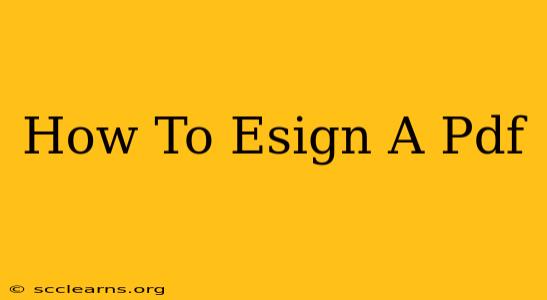E-signing PDFs has become essential in today's digital world. Whether you're finalizing a contract, approving a document, or simply needing a quick digital signature, knowing how to e-sign a PDF efficiently is crucial. This guide will walk you through various methods and best practices for e-signing PDFs, ensuring a secure and legally sound process.
Understanding the Importance of E-signatures
Before diving into the how-to, let's understand why e-signing is so important:
- Convenience: E-signing eliminates the need for printing, signing, scanning, and emailing documents, saving you valuable time and effort.
- Speed: Agreements can be finalized in minutes, accelerating business processes and workflows significantly.
- Cost-effectiveness: Reduces paper, printing, postage, and courier costs.
- Security: Many e-signature platforms offer robust security features to protect your documents and ensure authenticity.
- Environmental Friendliness: Reduces your carbon footprint by eliminating paper usage.
- Legality: E-signatures are legally binding in many jurisdictions, provided the proper process is followed.
Methods for E-signing a PDF
There are several ways to e-sign a PDF, each with its own advantages and disadvantages. Here are some popular options:
1. Using a Dedicated E-signature Software
Adobe Acrobat Pro DC: This is a powerful and widely used solution offering advanced features beyond just e-signing, including editing, creating, and managing PDFs. It provides a secure and legally compliant e-signature solution.
Other E-signature Software: Numerous other platforms are available, offering varying levels of functionality and pricing. Some popular choices include DocuSign, HelloSign, PandaDoc, and SignNow. These services often provide features like automated workflows, audit trails, and integration with other business tools. Research and choose the platform best suited to your needs and budget.
2. Using Built-in Features (Limited Functionality)
Some PDF readers, like Adobe Acrobat Reader, offer basic e-signature capabilities. However, these features are typically limited compared to dedicated e-signature software. They might not provide the same level of security and advanced features.
3. Using a Digital Pen and Tablet (For Stylus Signatures)
If you prefer a more traditional signing experience, you can use a digital pen and tablet to sign a PDF. This method produces a more natural-looking signature, but requires additional hardware.
Choosing the Right E-signature Method
The best method for e-signing a PDF depends on your specific requirements:
- For simple, occasional use: Built-in PDF reader features might suffice.
- For frequent use, advanced features, and legal compliance: Dedicated e-signature software is recommended.
- For a more natural signature feel: A digital pen and tablet provide a good alternative.
Best Practices for E-signing PDFs
To ensure a smooth and legally sound e-signing process:
- Review the document carefully: Ensure all details are accurate before signing.
- Understand the legal implications: Be aware of the legal implications of e-signing in your jurisdiction.
- Use a reputable platform: Choose a well-established e-signature provider to ensure security and compliance.
- Maintain a record of your signed documents: Keep a copy of all signed documents for your records.
- Securely store your signature: Protect your digital signature credentials.
Conclusion
E-signing PDFs offers numerous advantages, streamlining workflows and improving efficiency. By understanding the various methods and following best practices, you can confidently and securely manage your document signing needs. Choose the method that best aligns with your needs and budget for a seamless e-signing experience.

